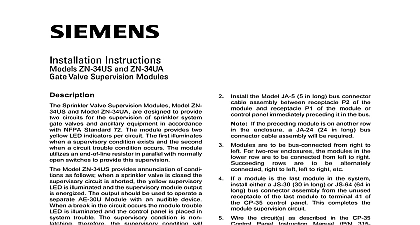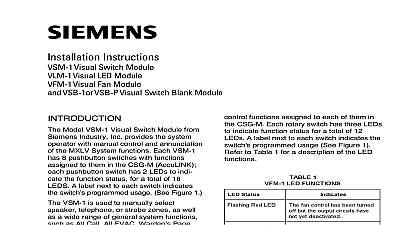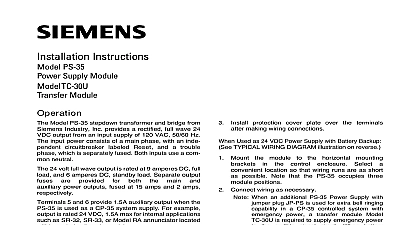Siemens ZU-35 ZU-35DS ZU-35TS Dual Zone Module, Installation Instructions

File Preview
Click below to download for free
Click below to download for free
File Data
| Name | siemens-zu-35-zu-35ds-zu-35ts-dual-zone-module-installation-instructions-4586937012.pdf |
|---|---|
| Type | |
| Size | 664.70 KB |
| Downloads |
Text Preview
Installation Instructions ZU 35 35DS 35TS Zone Module Dual Zone Module Model ZU 35 is designed to provide independent initiating circuits Up to thirty standard ionization and photoelectric detectors or flame de except model DF 3 DF 3A and DF 30 are sup by these modules module supplies a current limited output signal for the in alarm providing for activation of supplementary or annunciators dual zone module occupies one module space in the 3 rail structure and is interconnected via a ten pin and harness assembly any quantity of shorting type contact devices as manual stations and thermal detectors also can be and intermixed on each initiating circuit Terminals are provided for each power limited circuit either NFPA Class A Style D or Class B Style B control enclosure addition to all the same features of the ZU 35 each zone is with a disconnect switch which will disable the zone action will cause a zone trouble and a system trouble until the switch is returned to normal ZU 35TS is furnished with a 3 position momentary con test switch for each zone The normal switch position is the center one side position will test the zone trouble sig and the other will test a zone alarm signal This is a re for US Coast Guard approval for use on marine and the module is Coast Guard approved Ratings 31mA 24VDC 272mA 24VDC operation of a detector or shorting type device installed the initiating circuit the module will lock into an alarm con initiating the start of the sequential functions designed the system These functions may include sounding au devices operating alarm transmitters closing doors down fans and equipment recalling elevators and similar functions required for life and property safety addition to the system alarm a red Alarm LED on the face the dual zone module will be illuminated for that particular circuit A trouble on either detection circuit will be annunciated with a yellow LED one for each circuit Industry Inc Technologies Division Park NJ 315 083222 18 Mount the module to the horizontal mounting brackets in the Model JA 5 5 in long bus connector cable between receptacle P2 of the module and P1 of module or control panel preceding it in the bus If the preceding module is on another row in the a JA 24 24 in long bus connector cable will be required Modules are to be bus connected from right to left For enclosures the modules in the lower row are to connected from left to right Succeeding rows are to be connected right to left left to right etc a module is the last module in the system install either JS 30 30 in long or JS 64 64 in long bus connector from the unused receptacle of the last module terminal 41 of the CP 35 control panel This completes module supervision circuit Wire the circuit s as described in the CP 35 Control Panel Manual P N 315 085063 Installation and Refer to the Wiring illustration If a zone is not used the EOL device should be to the alarm initiating circuit terminals 2 and 3 1 or 4 and 5 Zone 2 of the module a supplementary relay module annunciator or other module is used then the alarm outputs terminals Zone 1 and 7 Zone 2 should be connected to these Test to the CP 35 Control Panel Instruction Manual and Wiring Building Technologies Ltd Safety Security Products Kenview Boulevard Ontario 5E4 Canada Wiring 315 083222 18 CIRCUITS 18.1 VDC Unfiltered Full Wave Rectified 9mA 275mA Total zone initiating circuit resistance is 36 ohms max 9 ohms per line Unused spare zones must have an EOL device connected See individual detector for actual terminal connection numbers Maximum 30 detectors any combination of those listed on the table at the right allowed per circuit Also may use optional detector remote lamp or relay as indicated on the applicable detector instructions Positive and negative ground fault impedance threshold 40K ohms


